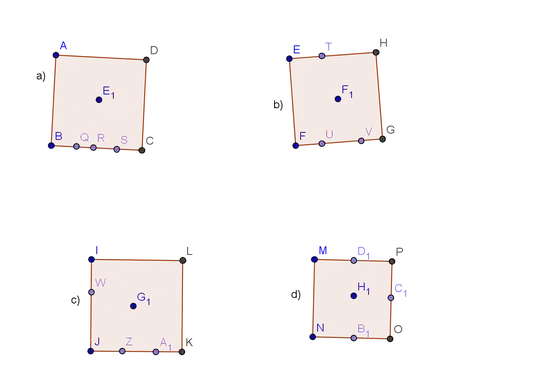As @joriki said "Wherever the first point is chosen, the "diameter" on which it lies divides the -gon into two symmetric halves, and the second and third points must be in opposite halves. The line connecting them must also lie above the centre (as seen from the first point), and if the second point is at a distance $x$ from the first point along the perimeter"
We can have the following definitions:
$\nu_1$, $\nu_2$, and $\nu_3$ are the first, the second, and the third point respectively.
event $B$: is to place $\nu_2$ and $\nu_3$ in the opposite halves of n-gon.
event $\bar{B}$: is to place $\nu_2$ and $\nu_3$ in the same half of n-gon.
event $A$: is to form the triangle having the centroid of n-gon within.
$L$ is the perimeter of n-gon.
$x$ is the distance between $\nu_1$ and $\nu_2$ along the shortest perimeter.
Note: Circle is a special case of n-gon, where n is approaching to $\infty$.
With above definition, we can use the following formula to describe what @joriki said:
$$
P(A) = \int_x P(A|x,B)f(x)P(B)dx + \int_x P(A|x,\bar{B})f(x)P(\bar{B})dx
$$
Because we know $P(A|x,\bar{B})\equiv0$ when event $\bar{B}$ happened. Therefore we could simply ignore the part with $\bar{B}$ involved, and rewrite above formula to become:
$$
P(A) = \int_x P(A|x,B)f(x)P(B)dx
$$
Then as we discussed before:
$P(A|x,B)$ is probability of forming the triangle having the centroid of n-gon within, when $\nu_2$ is placed at the distance $x$ away from the $\nu_1$ along the shorter perimeter, and $\nu_2$ and $\nu_3$ have been placed in the opposite halves of a n-gon.
$$
P(A|x,B) = \frac{x}{L/2} = \frac{2x}{L}\\
$$
$f(x)$ is the distribution of possible $x$. Because we could put the second point anywhere on the outline of the n-gon, and $x \in [0,L/2]$, so $f(x)$ is a uniform distribution $U[0, L/2]$
$$
f(x) = \frac{1}{L/2-0} = \frac{2}{L}
$$
$P(B)$ is the probability of placed $\nu_2$ and $\nu_3$ in the opposite halves of a n-gon
$$
P(B) = \frac{{{2}\choose{2}}}{{{2}\choose{2}}+{{2}\choose{1}}} = \frac{\frac{2!}{2!0!}}{\frac{2!}{2!0!}+\frac{2!}{1!1!}} = \frac{2}{2+2} = \frac{1}{2}
$$
The numerator is ${{2}\choose{2}}$, a binomial coefficient, meaning choose 2 halves from 2 halves to hold $\nu_2$ and $\nu_3$ respectively. And denominator is sum of ${{2}\choose{2}}$ and ${{2}\choose{1}}$, where ${{2}\choose{1}}$ means choose 1 half from 2 halves to hold both $\nu_2$ and $\nu_3$
As we discussed before $x \in [0, L/2]$, Thus
$$
\begin{align*}
P(A) & = \int_0^{L/2} \frac{2x}{L}\cdot\frac{2}{L}\cdot\frac{1}{2}dx\\
P(A) & = \frac{2}{L^2}\int_0^{L/2} x dx\\
P(A) & = \Big[\frac{2}{L^2}\cdot\frac{x^2}{2}\Big]\Big|_0^{L/2}\\
P(A) & = \frac{x^2}{L^2}\Big|_0^{L/2} = \frac{1}{4}
\end{align*}
$$
